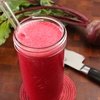Beetroot, also commonly known as the beet, is the root portion of the beet plant. Beets range in color from crimson red and golden yellow, to white, with one type reminiscent of candy canes with both red and white colors (Chioggia). This entire flowering plant is edible. While the leafy green stems can be slightly bitter, beetroot has an earthy, deep, sweet flavor that gets milder the lighter in color it gets. If you aren't the biggest beet fan, try out some mild golden beets or the Chioggia variety to start, and you'll be a beet lover in no time!
Peel it?
Unless your beet contains mold or rotting, there is no reason to peel a perfectly good beet.
Can I blend beets raw?
Yep! Blending it raw is what people usually do.
Also known as...
Common beet, garden beet, table beet, or red beet.
Washing Tip
Scrub beets vigorously with a vegetable brush under running water to remove dirt and debris. You can chop off the top of the beet where it meets the stems, along with the tail, since these parts can be difficult to clean.
History of the Beet Root
The common beet is a descendant of a variety that grew wild along the seashores of Europe, North Africa, and the Mediterranean. Ancient Romans were one of the first populations to harvest and consume beetroot, when originally the greens were the only part consumed. Beets became more widespread from the 16th to 19th centuries and were quickly noticed for their source of concentrated sweetness.
Fun Fact
Beets contain compounds called betacyanins, which give them their deep red pigmentation. These compounds don't always break down during digestion and can cause both urine and feces to turn beet colored or bright red. Do not fear if this happens to you.
Smoothie Recipes with Beet Roots

Beet & Berry 'em
You may hear that root vegetables are "gross" when put in...

Red Velvet
A beautiful smoothie that tastes as good as it looks. It'...

Discovering Earth
People avoid putting root vegetables in their smoothies b...
